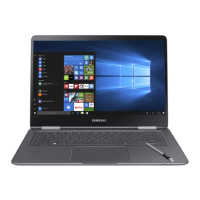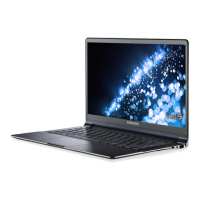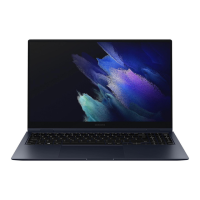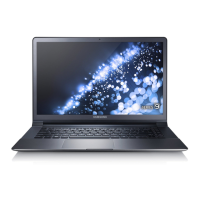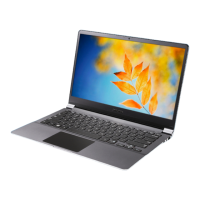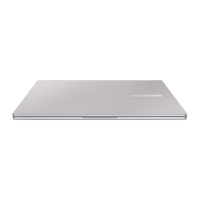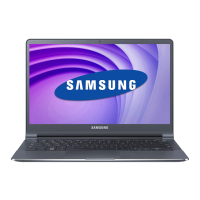Do you have a question about the Samsung NP940X3L-K01US and is the answer not in the manual?
Describes the purpose and scope of the user manual.
Explains icons and expressions used in the manual for instructions.
Details copyright information and usage restrictions for the manual.
Lists trademarks of Samsung and other companies used in the manual.
Advises on data loss prevention and backup.
Explains support for the original OS and consequences of changing it.
Suggests optimal screen resolutions for display.
Explains how storage and memory capacity are represented.
Describes the layout and components of the computer's front view.
Identifies and describes components of the computer's front view.
Identifies and describes components of the computer's right view.
Identifies and describes components of the computer's left view.
Identifies and describes components of the computer's bottom view.
Provides instructions on how to turn the computer on and off.
Explains the Windows activation process on first use.
Details methods for unlocking the computer's lock screen.
Provides a brief overview of the Windows operating system.
Explains how to access help information within the system.
Guides on adjusting system settings via the Control Panel.
Explains how to use multiple virtual desktops for multitasking.
Describes the function and use of the Windows Action Center.
How to convert the laptop into a tablet mode.
Methods to switch the computer display to tablet mode.
Introduces the optional touch screen functionality.
Details common touch screen gestures for interaction.
Explains how to drag items using the touch screen.
Describes how to zoom in/out using touch screen gestures.
Explains how to scroll using touch screen gestures.
Guides on using the virtual keyboard for text input.
How to change keyboard layouts for different input methods.
Instructions for copying and pasting text using touch/mouse.
Overview of the physical keyboard and its functions.
Explains how to use function keys (hot keys) for shortcuts.
Overview of the touchpad and its basic functions.
How to move the cursor using the touchpad.
How to perform click actions with the touchpad.
How to perform double-click actions with the touchpad.
Explains advanced touchpad gestures like swiping and pinching.
How to customize touchpad gesture settings.
How to lock and unlock the touchpad.
Information about supported memory card types and usage.
Step-by-step guide for inserting a memory card.
Step-by-step guide for removing a memory card.
How to format a memory card to erase data or prepare it.
Information on connecting the computer to an external display.
Detailed steps for connecting an external display via HDMI.
Explains different display modes for external connections.
Information about connecting to wireless networks.
Step-by-step guide for connecting to a Wi-Fi network.
Explains what an Access Point is in networking.
How to turn off the Wi-Fi feature to save power.
How to activate Airplane mode to disable wireless functions.
General information on using pre-installed applications.
Guide to the Samsung Settings application for system configuration.
Instructions for installing and updating Samsung software and drivers.
How to access Samsung's online support service for assistance.
Information on using the Samsung PC Help app for troubleshooting.
How to adjust the screen brightness using keyboard or taskbar.
How to adjust screen settings for different activities.
How to control system and sound volume using keyboard or taskbar.
How to enter and configure BIOS settings.
Overview of the BIOS setup screen interface and navigation.
How to set and manage boot passwords for system security.
Explains different password types (Supervisor, User, HDD) in BIOS.
Step-by-step guide for setting a boot password in BIOS.
How to remove existing boot passwords from BIOS.
How to change the boot device priority in BIOS setup.
How to calibrate the laptop's battery for accurate charge display.
General information about the internal battery and its care.
Step-by-step instructions for charging the laptop battery.
How to check the battery charge level via the taskbar icon.
How to check battery charge when the computer is powered off.
Tips and features to conserve battery power.
Information on battery lifespan and maintenance.
Information about the Samsung Recovery application for system restore.
Steps to restore the computer to its original factory settings.
How to back up important data and system settings.
How to restore the system from a previously created backup.
How to create a disk image for drive replacement.
How to reinstall Windows using built-in recovery tools.
Steps to uninstall applications from Windows.
Instructions on booting the computer in DOS mode via USB.
Explains the purpose and function of the Recovery Area partition.
Defines a recovery image and its role in system restoration.
Guide to restoring the system using Windows recovery if Samsung Recovery is unavailable.
Explains why HDD capacity shown in Windows differs from product specs.
Addresses common issues like automatic power-on when opening the LCD.
Lists the technical specifications of the computer.
Guidelines for proper posture and setup to prevent injury.
Specific advice on maintaining good posture for the back and neck.
Advice on maintaining proper arm and hand posture during use.
Recommendations for optimal eye position and screen lighting.
Advice on safe audio volume levels and headphone use.
Guidance on using the computer in various environments and conditions.
General information on powering and charging the device.
Specific instructions for charging the battery on an airplane.
How to properly use the AC power adapter and plug.
How to use the auto adapter with a 12VDC power supply.
How to use the airplane charging converter for power.
General safety warnings and precautions for using the computer.
Safety guidelines for installing and setting up the product.
Safety precautions related to power cords, adapters, and electrical outlets.
Safety precautions concerning battery, AC adapter, and accessories.
Safety guidelines related to computer usage in various environments.
Safety precautions when upgrading or disassembling the computer.
Safety guidelines for storing and moving the computer to prevent damage.
Precautions to take when carrying the notebook with other items.
Warnings about blocking vents and inserting objects into ports.
Safety advice regarding the proper use of a pen.
Precautions to prevent fire hazards related to the product.
Warnings about keeping the computer away from magnetic materials.
Restrictions on using the computer in hospitals and aircraft.
Advice on preventing data loss from the hard disk drive.
Lists situations that can damage the hard disk drive and data.
Information on LCD quality standards regarding bad pixels.
Instructions for safely cleaning the LCD screen.
General overview of safety instructions for the product.
Guidelines for safely setting up the computer system.
Precautions and advice for safe computer usage.
General instructions for operating and servicing devices.
Guidance on using only recommended replacement parts and accessories.
Instructions and warnings regarding proper battery disposal.
Safety information related to laser devices in CD/DVD drives.
Instructions for connecting and disconnecting the AC adapter.
Requirements for power cords used with the computer.
General requirements applicable to power cord sets across countries.
Overview of regulatory compliance and wireless device usage.
General guidance on operating wireless devices, including RF exposure.
Safety requirements and notices specific to the USA and Canada.
Compliance information regarding unintentional radio frequency emissions (FCC Part 15).
Compliance information regarding intentional radio frequency emissions (FCC Part 15).
Information on RF signal exposure and certification.
Details FCC certification for RF signal exposure limits.
Compliance for unintentional emissions in Canada (ICES-003).
Compliance for intentional emissions in Canada (RSS 210).
Homologation and technical requirements for Brazil.
Information on CE marking and compliance with EU directives.
Details of EU directives (EMC, Low Voltage, R&TTE) the equipment complies with.
Radio approval details for products with EU-approved devices.
Statements of compliance with EU R&TTE Directive in various languages.
Contact details and addresses for Samsung manufacturing entities.
Restrictions on 802.11b/802.11g radio usage in the EEA.
Caution regarding potential explosion if the RTC battery is replaced incorrectly.
Information on the correct disposal of Waste Electrical & Electronic Equipment.
Specific disposal guidelines for batteries and electronics in the USA.
Information about Samsung's program for recycling product packaging.
| Color | pure black, black |
|---|---|
| OS | windows 10 |
| Software | n/a |
| Numeric Keypad | no |
| Touch Screen | yes |
| Screen Type | touchscreen led |
| Screen Size | 13.3 inches |
| Screen Resolution | 3200 x 1800 (quad hd+) |
| Processor Brand | intel |
| Processor Model | intel 6th generation core i7 |
| Processor Model Number | n/a |
| Storage Type | ssd |
| SSD Capacity | 256 gigabytes |
| SSD Interface | sata iii |
| Type of Memory | lpddr3 |
| System Memory | 8 gigabytes |
| System Memory Speed | 1866 megahertz |
| Audio Type | high-definition with soundalive |
| Speakers Type | two 2w stereo |
| Backlit Keyboard | yes |
| Card Reader | yes |
| Touchpad | multigesture |
| Battery Type | lithium-ion |
| Depth | 8.69 inches |
|---|---|
| Height | 0.59 inches |
| Width | 12.39 inches |
